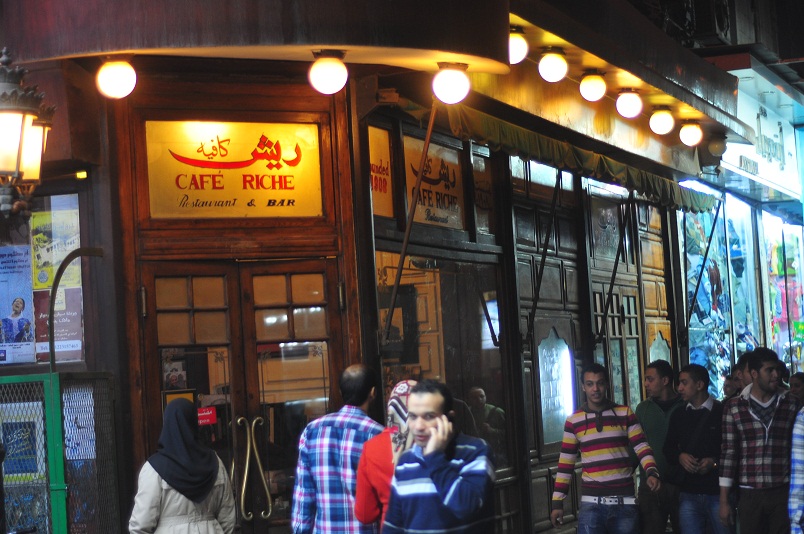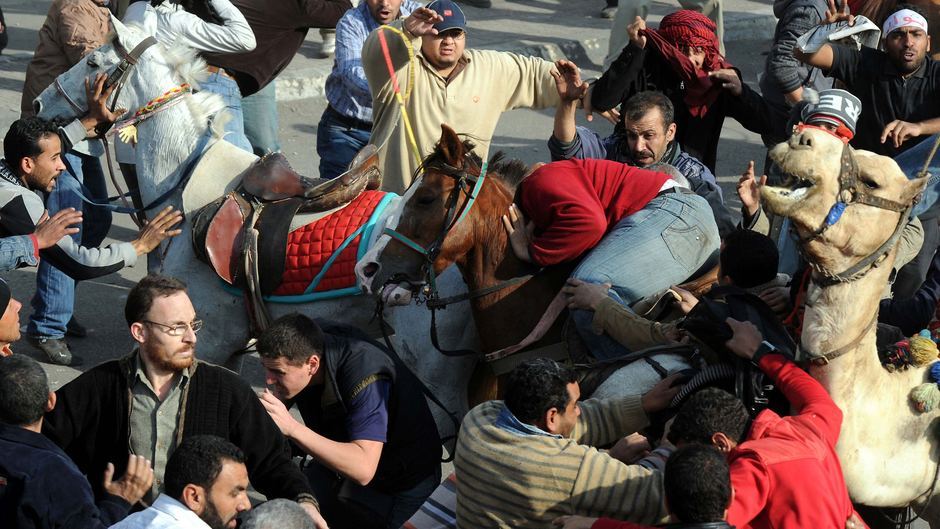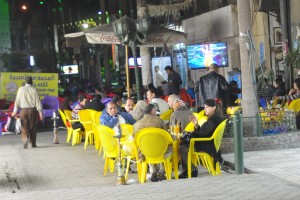
Hassan Ibrahim
In his autobiography The Days, the dean of Arabic literature Taha Hussein described a scene he encountered daily as a young man back in 1902. The sounds and smells impressed themselves on his memory. “Passing through the door, he [Hussein] felt some mild heat on the right side of his face, light smoke entering his nostrils and an intriguing bizarre sound… going in and out of Al-Azhar, he understood that it was the gurgling sound of hookahs prepared by the coffeehouse for merchants to smoke.”
Later on in the book, he depicted the dynamism that coffeehouse produced in the neighbourhood, the interactions and activities of the patrons and the waiters’ rituals for serving drinks, igniting charcoal for hookahs and sprinkling water in front of the coffeehouse to keep the heat and dust at bay.
Coffeehouses became a subject of fascination for orientalists and European travellers under the reign of the Ottoman Empire. The picture Hussein drew was an archetype of the coffeehouses scattered throughout the alleyways of Cairo at that time. Other writers such as Naguib Mahfouz, Nobel laureate for literature and the author of The Cairo Trilogy, depicted coffeehouses in his novels to emphasise their role in the Egyptian public space.
In Cairo’s cosmopolitan Downtown, coffeehouses (ahawi), blend with old European style cafes. Ahawi have existed for centuries. They are places where commoners (particularly men) meet to spend their leisure time after a long day. Men at the ahawi would listen to a singer, play backgammon and dominos, and discuss life. They are known to be cheap (a cup of tea or coffee goes for as little as a pound), provide open air seating and give a taste of the authentic Egyptian spirit. In short, they were the place to go to socialise and relax.
European style cafes opened under Khedive Ismail, Egypt’s ruler from 1863-1879, and they were linked to the Greek population then living in Cairo. They attracted a different audience from another social class; effendis (young professional Egyptians) and people who had been exposed to western ideas. As well as being venues for passing the time, these cafes sought to recreate a European atmosphere, offering a stage for entertainment and a space for cultural salons.
Strolling around Talaat Harb Square can make one nostalgic; it is where the past meets the present. French colonial buildings line the streets branching out from the square. The European style patisserie and tearoom Groppi, with its exquisite architecture, stands on the main corner surrounded by bookstores and shops. Although the scene may bring back bitter memories of colonisation for some, it also commemorates what Egyptians call el-zaman el gameel, the good old days. Walking from Groppi towards Tahrir Square, another relic of the past is still buzzing and overcrowded with customers, especially at night.
Established in 1908, Cafe Riche restaurant and bar has been witness to much of Egypt’s modern history. The windows of the wood panelled exterior reveal a unique interior. Wooden tables dressed in striped red and white tablecloths and chairs emblazoned with the cafe’s name are spaced within the restaurant to offer a sense of privacy to customers.
Veneered pillars separated by glass panes covered with white curtains make one of the outside walls. The other bears display cases featuring faded black and white pictures alongside contemporary photographs of Mina Danial and Sheikh Emad Effat (two martyrs of the 25 January revolution). The alluring entrance gives pause to many passersby, who stop to peer through the glass facade to figure out what this place is about.
Inside, a bar sits to the right of the entrance. Liquor is served and the smell of beer mixes with the aroma of coffee. Beside the bar, a cast staircase descends to the basement. Riche’s cellar holds a story of its own. Before the 1919 revolution, Riche’s Greek owner helped Egyptian students to print political pamphlets against the British occupation. The basement had a hidden door leading into a neighbouring alley and students used it to escape police raids. The printer the students used is still preserved in the cellar.
The late Egyptian historian Yonan Labib noted that at different times in history, demonstrations used congregate and depart from the Riche, especially when the student movement became active. After the nationalisation of the Suez Canal, some opposition figures were arrested in the cafe.
Am Felfel has served at the Riche since 1943. He migrated from Nubia and started working the cafe aged 13. A repository of oral history, if prompted Am Felfel will reminisce about the political activism he has witnessed at the cafe. “everyone used to sit here and especially communists whom people used to fear,” he says in a quavering voice.
“Then when communism retreated, other currents emerged. Under Nasser, people used to say the walls have ears, so they wouldn’t talk explicitly about politics, but when Sadat came, people talked politics more than before and the same happened with Mubarak in the beginning.”
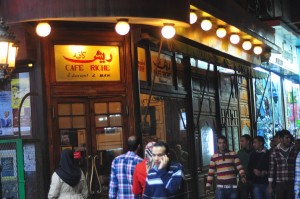
Hassan Ibrahim
“When Egypt signed Camp David, a demonstration burst out of Riche,” he remembers.
Over time Riche became a beacon for prominent Egyptian and foreign thinkers, politicians, artists, journalists and writers. Through its cultural salon, located far from the bar next to the guest area, Riche hosted many discussions. More than just a cafe, restaurant or bar, it connected politics to literature and art. In the past Riche was larger than it is today; it owned a stage that extended to the corner of Talaat Harb Square. Om Kalthoum was among several singers who sang there.
But perhaps the largest contribution to Riche’s reputation was Naguib Mahfouz’s visits. He never took a day off from the cafe. Am Felfel used to serve plain coffee to Mahfouz. He saya, “Mahfouz used to walk from home to here. He bought his newspapers and read them here. He used to be a humble man who to talked to everyone and stands when greeting everyone.”
According to Am Felfel, the revolution made the cafe popular among youth who did not previously know about it. He watches the youth meet with the elders who have been coming the cafe faithfully for year.
“I don’t consider myself working,” Am Felfel concludes. “I’m a partner in Riche, it’s like home for me.”
Leaving Riche and heading right, another historical coffeehouse stands nearby. Though much less sophisticated than the French style Riche, Zahret el-Bostan has also stood the test of time and is believed 80 years old. Underneath its blue illuminated sign reads “the concourse of literati and artists.”Also a venue for intellectuals, el-Bostan has none of the snobbishness of cafe Riche.
Ateef, a waiter who has been working at el-Bostan for 28 years, says, “el-Bostan has been considered a forum for all intellectuals. I hear people reciting poetry, playing Oud, talking about painting and art.”
El-Bostan’s oldest customers sit in front of the kitchen, while newcomers are relegated to the alleyway behind the Riche. The discrepancy in appearance between Riche and el-Bostan seems intentional. The latter is open to the street; no roof, no walls no doors. With plastic tables and chairs, the setting is informal and people can hold loud discussions without restraint.
A professor at the faculty of fine arts of Helwan University Ahlam Fekry says, “sitting in this coffeehouse in the street, signifies our liberty. Our people love freedom and coffeehouses give them that. This is where you meet the other and people from across the class spectrum.”
Although el-Bostan is in most ways a typical coffeehouse, it is also unique in that its clientele has expanded to include women. Baladi (common) coffeehouses are strictly reserved for men and women can expect to be excluded, criticised or harassed if they sit in such an establishment.
However, el-Bostan and a few similar coffeehouses provide a sanctuary for women as well. Professional women come to mingle with their male counterparts and hold discussions of their own. Housewives accompanying their families also come to el-Bostan for an outing.
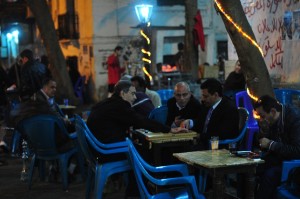
Hassan Ibrahim
“El-Bostan safeguards women in that sense,” Fekry says. “We are able to come here and contribute to the intellectual momentum that is born here daily.”
Medhat Taha, a writer and a regular customer at el-Bostan, says, “my generation of the 1970s started coming to el-Bostan after we stopped going to Riche. We did not like the selectivity and the elitist nature Riche turned to acquire.”
Taha admires the easy accessibility the commoners have to el-Bostan. He says, “we sit around and people approach us to ask about politics and other things. We have no problem talking to them because where from them. This kind of interaction is what makes this place so great.”
Some of the old customers of el-Bostan are reminiscent of the time when Riche was the focal point for political and cultural activity. It still preserves its significance, but its lives off its history to a great extent.
Abdo Ghobair, a novelist, believes that the 1970s generation chose el-Bostan because it was within “the strategic depth” of Riche which they wished had conserved its political and cultural activism.
Though el-Bostan is usually overcrowded, it empties out on days of “million man” marches to Tahrir, illustrating its popularity with revolutionary youth. Ghobair comments on the revolutionaries at el-Bostan, saying “here is like a rest house for the revolutionaries. They come here refresh themselves, rest for a while then go back to their battles in the square.
“Coffeehouses couldn’t play a bigger role,” he says.
Leaving el-Bostan, on the way to Mohamed Naguib Metro station on Mohamed Sabry Street lie a handful of coffeehouses known as el-Borsa. The area around the stock exchange is congested cafes and restaurants making a congested, but lively scene. Alleys are filled with colour coded plastic chairs and tables to demarcate territories and customers.
As a Cairo coffeehouse, el-Borsa stands out. “It is political, cultural and romantic,” says Am Ahmed, one of the staff.
He is right, in the afternoon schoolgirls sit with their boyfriends and college students chuckle over the coffees. However, the scene changes in the evening, when activists and NGO workers congregate for a drink and food from a nearby outlet.
Samer Elshehawi, 24, a master’s student involved with human rights organisations, started going to el-Borsa during the 18 days of the uprising. He would go there to recharge with friends. He says, “later, I started going there again with new colleagues I knew from a human rights course at the Cairo Institute for Human Right Studies and I got used to Borsa and its atmosphere that encompasses cultural tolerance and gender equality.”
He adds, “like other coffeehouses, Borsa is cheap but not exclusive to one social class. You can people from different socio-economic and cultural backgrounds.”
Jaida Gamal, 20, is a finance major at the American University in Cairo. Though she comes from a well-off family, she started going to Borsa through a political campaign she was involved in before the revolution. She says, “we used to hold all our meetings there. After the revolution when we wanted to rest after protests we went there for a drink.”
She playfully adds, “the best thing about Borsa is that for each customer, there is probably five secret government agents to report on them.”
For her, Borsa captures the true Egyptian spirit. “The people who sit there are nowhere else. Even the waiters yell that they are coming with a certain melody that draws a smile on your face.”
El-Bostan is a bastion for intellectual exchanges and Borsa is for youthful gatherings and political activism, but not everyone wants to indulge in intellectual or political discussion. Walking away from Borsa up Orabi Street, Om Kalthoum’s coffeehouse chose to be apolitical and focused instead on playing all of Om Kalthoum’s back catalogue. However, that failed miserably every time someone stirred a political discussion, especially after the revolution.
Haj Hussien, the current owner of the coffeehouse says, “before the revolution all discussions were about football. Now that’s changed and people talk politics.”
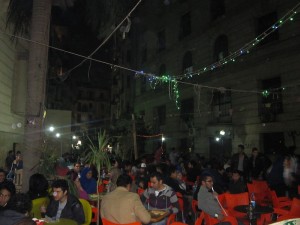
Sarah El Masry
Om Kalthoum is a typical baladi ahawa established in 1936. Originally named el-Tawfik, the coffeehouse changed its name when the composer Mohamed Abdel Wahab starting hosting the Star of the East in the building next door.
The owner at that time played Om Kalthoum records without permission, which caused legal issues for the coffeehouse. Haj Hussien says, “they asked her permission to play her songs and proved that they first played the songs with good intentions and not for commercial reasons. So that problem was solved. The name changed after that incident.”
Surprisingly, nearby there is another Om Kalthoum coffee shop with similar claims to being the authentic one. It has a marble plaque at the entrance with an inscription announcing “established in 1948.” However, the consensus seems to be that the one on Orabi Street is the authentic one.Am Gameel, an old shop owner by the ersatz coffeehouse used to go to the authentic one with a friend. He says, “we used to find everyone singing with Om Kathoum. It used to be emotional, but soothing.”
***
Coffeehouses like el-Bostan, el-Borsa and their ilk have accepted women in their realm. Other baladi coffeehouses like Om Kalthoum remained traditional, retaining a male only clientele. Historical coffeehouses like Riche are reminiscent of the past, but continue to claim their significance up to the present. Today, like in the past, coffeehouses are not merely recreational spaces; they are an arena for challenging authoritarianism and establishing a platform for art and literature, and political and cultural activism.
No matter how diverse coffeehouses became, their place and function in the public sphere are indispensable.
